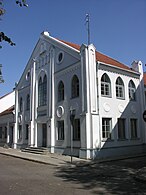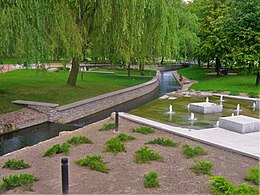|
Marijampolė
Marijampolė (ⓘ; also known by several other names) is the capital of the Marijampolė County in the south of Lithuania, bordering Poland and Russian Kaliningrad Oblast, and Lake Vištytis. The city's population stood at approximately 48,700 in 2003. It is the cultural centre and largest settlement of the historical region of Suvalkija (Sudovia). Marijampolė is the seventh-largest city in Lithuania and has been a regional center since 1994. The city covers an area equal to 205.07 square kilometres (79.18 sq mi). The Šešupė River divides the city into two parts which are connected by six bridges. NamesThe city has also been known as: מאַריאַמפּאָל (Yiddish); Marijampolis, Mariampol; Starapole; Pašešupiai; Marjampol; Mariyampole; and Kapsukas (1955–1989). History  The settlement was founded as a village called "Pašešupė", after the nearby river of Šešupė. As such the town was first mentioned in 1667. In the 18th century the village, at that time belonging to the Catholic Church, grew to become a market town and its name was changed to Starpol or "Staropole", after a new village built for Prienai starost's guards in the vicinity in 1739.[1] The settlement was destroyed by a fire in 1765. After the disaster, the wife of contemporary starost of Prienai, Franciska Butler, née Ščiuka,[2] financed a new church and a monastery for the Congregation of Marian Fathers.[1] Following the foundation of the monastery, a new town was built in the area. It was named "Maryampol", after the Blessed Virgin Mary (Marya-), with the Greek suffix -pol denoting a town.[3] On 23 February 1792 King of Poland and Grand Duke of Lithuania Stanisław II Augustus granted the "townlet of Mariampol" with Magdeburg Law and a privilege of market organisation. Following the Partitions of Poland the town was briefly part of Prussia. However, after the Napoleonic Wars it was transferred to Congress Poland ("Russian Poland"). In the 19th century the town continued to grow, mostly thanks to a large number of Jewish and German settlers. In 1817 the town became the seat of a separate powiat within the administrative system of the kingdom.[1] In 1827 the town had 1759 inhabitants. By 1861 the number had grown to 3718, 3015 of them being Jewish.[1] A fire consumed many wooden homes in 1868. As a result, many houses were rebuilt of stone.[4]  Following the January Uprising and the Russian suppression of the former Commonwealth lands, the powiat of Maryampol was seriously diminished.[1] Around that time also the monastery gained prominence as it was the only monastery owned by the Marians that was not closed down by the tsarist authorities.[5] As the surroundings of the town were primarily inhabited by Lithuanians,[1] the town became the centre of the Lithuanian national revival. The proximity of the Prussian border made the smuggling of books in Lithuanian language, banned in Imperial Russia, easier. Among the most notable Lithuanian scholars and writers active in Mariampol at that time were Kazys Grinius, Jonas Jablonskis and Vincas Kudirka.  Following World War I the town became part of Lithuania and was renamed to its current name Marijampolė. During World War II Marijampolė was occupied by the Soviet Union. During 1940–1941 Soviet authorities deported several hundred inhabitants of Marijampolė. In 1941 Nazi Germany occupied the town. On 1 September 1941, between 5,000 and 8,000 Jews from Marijampolė, Kalvarija and elsewhere, along with people from other backgrounds, were murdered. Their bodies were placed in mass graves near the Šešupė River. Most of the murderers were Lithuanian.[4][6] In the war the town was heavily damaged and almost emptied. On July 31, 1944 Soviet army once again entered the city. The following year its counter-intelligence SMERSH repressed about 500 people from Marijampolė. During the first years of Soviet occupation in 1944–1953 Soviet deportations from Lithuania to Siberian gulags included somewhere between 5,000 and 6,000 Lithuanians from Marijampolė county.[7] In late postwar years the city was rebuilt and repopulated with inhabitants from other parts of Lithuania. About 98% of Marijampolė's inhabitants are ethnic Lithuanians.[8] On 9 April 1955 Communist authorities of the Lithuanian SSR renamed the town "Kapsukas" after a Lithuanian Communist politician Vincas Mickevičius-Kapsukas.[9] The old name was restored in 1989, the year before Lithuania declared its independence from the Soviet Union. Marijampolė has been the administrative centre of the county since 1994. In 2018, in the 100th anniversary of the restoration of the independence of Lithuania, the city of Marijampolė became the cultural capital of Lithuania. The Anshe Sholom B'nai Israel synagogue in Chicago was founded by immigrants from Marijampolė. Other Jewish migrants from Marijampolė settled in Manchester and Leeds, United Kingdom. TransportMarijampolė is accessible by railway via the Kaunas-Šeštokai-Alytus line. The town is located at the crossroads of two major highways: The Via Baltica connects Helsinki with Central and Southern Europe, and the European route E28, which runs between Berlin, Germany, and Minsk, Belarus. Industry and economy Marijampolė is connected to its partners by business, sport, education, tourism, and other ties. Marijampolė's local means of mass media include a local television station, a local radio station, the newspapers "Marijampolės laikraštis", "Suvalkietis", "TV savaitė", "Sugrįžimai", and magazine "Suvalkija". Culturally, Marijampolė enjoys one cinema and a municipal drama theater. Marijampolė is a regional centre of light industry enterprises, construction, transport and trade. It has also become home to one of the largest second-hand car markets in Europe.[10] Education  Marijampolė has a strong educational system with state education institutions. The city is the seat of Marijampolė University of Applied Sciences as well as of nine pre-school institutions, six nursery schools, one primary school, 12 lower secondary schools, nine secondary schools, four gymnasiums, a youth school, an adult education center, five additional training establishments, three non-state education institutions, a music school of Christian Culture, the Gymnasium of Marijonai, and the R. Vosylienė languages school. Marijampolė MunicipalityMarijampolė has a City Council with 27 members. The members of the City Council represent different Lithuanian political parties. The Marijampolė Municipality is adjacent to the Vilkaviškis District Municipality in the west, Kazlų Rūda Municipality in the north, Kalvarija Municipality in the south, and the Prienai District Municipality and Alytus District Municipality in the east. The town of Marijampolė and its six surrounding communities make up the territory of Marijampolė Municipality. They are: Gudeliai, Igliauka, Liudvinavas, Marijampolė, Sasnava, and Šunskai communities. Marijampolė Municipality covers 755 square kilometres (292 sq mi) of land; 72% of which is an agricultural area, 12.3% is covered by forests; 4.2% – towns and villages, 2% – industrial enterprises and roads, and 6.9% – area used for other purposes. Twin towns — sister citiesMarijampolė is twinned with:[12]
Notable people
Gallery
Notes and references
External linksWikimedia Commons has media related to Marijampolė. |
||||||||||||||||||||||||||||||||||||||||||||||||||||||||||||||||||||||






















